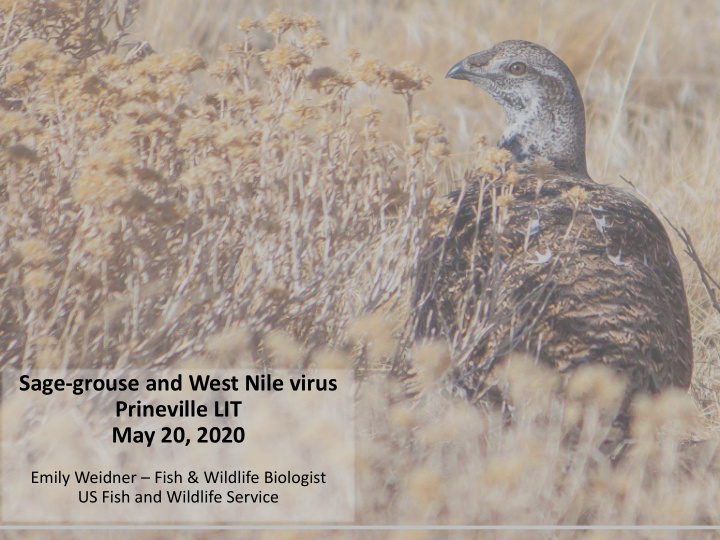



Sage-grouse and West Nile virus Prineville LIT May 20, 2020 Emily Weidner – Fish & Wildlife Biologist US Fish and Wildlife Service
2 Threats Habitat loss and Recreation and Isolated/small* Predation* Disease* Disease fragmentation hunting* Land Drought and Fire* Invasive species development Grazing* mesic habitat* and conversion Conifers* Urbanization Annual grasses* Infrastructure* Horses/burros Energy/Mining* *Applicable threats in 2017 Brothers CFA
3 West Nile virus (WNv) • Reemerging pathogen • Same genus as dengue, yellow fever, and zika • Arbovirus (ARthropod-BOrne virus) • Culex spp. primary vectors • Birds serve as primary reservoir • American robin likely responsible for maintenance and transmission across the landscape • Causative agent of West Nile fever in humans
4 West Nile virus (WNv) Evans et al. 2017 Centers for Disease Control and Prevention (2017)
5 WNv in sage-grouse • 2003, first documented WNv mortalities • Alberta, Montana, Wyoming • 2006, Malheur County, Oregon • Variable mortality and low resistance to infection • Affects all age classes and both sexes • Mortalities typically occur July though September • Considered an endemic stressor Naugle et al. Ecology Letters (2004); USGS NWHC (2006); Clark et al. Journal of Wildlife Diseases (2006); Taylor et al. PLOS On e (2013)
6 Vector Primary transmission cycle Reservoir Dead end/incidental hosts Centers for Disease Control and Prevention (2013)
7
8 A B Plowright et al. Nature Reviews: Microbiology (2017)
9
10
11
12 Difficult to assess… • Wildlife move on large scales and are cryptic • Field work requires substantial time, labor, and a uniform effort • Must have diseased bird in-hand or birds must survive in order for WNV to be detected • Potentially biased population metrics • Transmission and outbreaks are temporally and spatially patchy on the landscape • Low occurrence and equivocal results in serosurveys
13 Counting sage-grouse • Lek count data: only long-term, range-wide dataset available for evaluating trends in sage-grouse population • Imperfect detection (sightability & lek attendance) • Counts may inaccurately reflect changes in population abundance when detection of individuals is not constant for surveys either within or among years Fremgen et al. Journal of Wildlife Management (2016)
14 Landscape • Spatial and temporal variation in WNV transmission moderates WNV impacts on species • Spatial - range of habitats, and WNV transmission is lower in one of these habitats, then this area may serve as a refuge from infection • Temporal - intensity of WNV transmission may temper impacts and allow recovery in low transmission years Kilapatrick and Wheeler, Journal of Medical Entomology (2019)
15 Daversa et al. Proceedings of the Royal Society B (2017)
16 Low occurrence & equivocal results These two aspects suggest: 1. Sage-grouse have not been exposed to WNV and haven’t had an opportunity to develop antibodies 2. WNV is lethal for the majority but a limited number of birds survive infection and develop antibodies 3. Sage-grouse mount an immune response other than producing WNV-specific antibodies, thus making detection difficult
17 TAKEAWAY While compelling, linking sage-grouse declines to WNV arrival in Oregon is correlational at best. OPTIONS • Continue Brothers monitoring in 2020 • BLM implementing project at four locations • Expand monitoring into high-risk areas • Baker pilot in 2019, and continuing for 2020 and 2021 • Assess sage-grouse habitat use in water-limited areas • Model WNV risk on the Oregon landscape
Questions? 18 The Ecology of Disease , Olaf Hajek
Recommend
More recommend